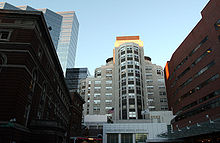- Medical centers in the United States
-
- This article discusses the major medical centers in the U.S. For all hospitals, see List of hospitals in the United States. For a general discussion about U.S. health care see Health care in the United States.
Medical centers in the United States are conglomerations of health-care facilities including hospitals and research facilities that also either include or are closely affiliated with a medical school. Although the term medical center is sometimes used to refer to any concentration of health-care providers including local clinics and individual hospital buildings the term is more properly used to refer to larger facilities or groupings of facilities that include a full spectrum of health services, medical education and medical research.
The major medical centers represent the crown jewels of health care in the United States. They vary greatly in their organization, the services they provide, and their ownership and operation.
Contents
Overview
In the United States, ownership of the health care system is mainly in private hands, though federal, state, county, and city governments also own certain facilities. Many major hospitals, generally the backbone of any medical center, are non-profit and many of these have their origins in religious organizations. Despite their non-profit status, affiliation with private ventures and major medical schools often allows them to maintain state-of-the-art facilities and services. The non-profit hospital's share of total hospital capacity has remained relatively stable (about 70%) for decades.[1] There are also privately owned for-profit hospitals as well as government hospitals in some locations, mainly owned by county and city governments.
Major medical centers provide many specialized services, some even containing multiple specialized hospitals and clinics each dedicated to specific types of patients and/or services. Additionally they are centers of medical education, centers of medical research, and incubators for medical innovation and technology. A given medical center may include a medical school in the same complex as the rest of the facilities or may be closely affiliated with a medical school on a nearby campus. Similarly a given medical school may be closely associated with multiple tightly linked hospital campuses which function to some degree as a unit though the group may not be referred to as a single medical center (e.g. the Harvard Medical School network of teaching hospitals).
There are about 1,100 teaching hospitals in the United States. Approximately 375 of the larger institutions belong to the Association of American Medical Colleges’ Council of Teaching Hospitals and Health Systems (COTH). COTH teaching hospitals train about 75 percent of residents yearly and provide more than 40 percent of all hospital charity care in the nation.
Major medical centers
Although any rankings of medical centers are highly subjective, this section describes some of the largest and most prominent centers in the nation. Note that the rankings and importance of individual hospital facilities may be different from the medical centers that they belong to.
Johns Hopkins
Main article: Johns Hopkins HospitalThe Johns Hopkins University School of Medicine, located in Baltimore, Maryland (USA), in addition to operating a major medical school, operates the Johns Hopkins Hospital, which consists of both a teaching hospital and biomedical research facility. It was founded using money from a bequest by philanthropist Johns Hopkins. The Johns Hopkins Hospital and the Johns Hopkins School of Medicine are the founding institutions of modern American medicine and are the birthplace of numerous traditions including “rounds,” “residents” and “housestaff”.[2] The Johns Hopkins Hospital is the birthplace of many medical specialties including neurosurgery, urology, endocrinology, pediatrics, cardiac surgery[3] and child psychiatry.[4][5][6] It is widely regarded as one of the greatest hospitals in the United States and the world.[7] It has been ranked by U.S. News and World Report as the best overall hospital in America for 20 consecutive years.[8][9][10]
Mayo Clinic
Main article: Mayo ClinicMayo Clinic is a non-profit organization and internationally renowned group medical practice headquartered in Rochester, Minnesota. Its headquarters consist of the Mayo Medical School, the Mayo Graduate School, the Mayo College of Graduate Medical Education, and several other health science schools. Its research facilities are in Rochester, Minnesota, in addition to hospitals and clinics in Jacksonville, Florida, Scottsdale, Arizona, and Phoenix, Arizona. Mayo Clinic partners with a number of smaller clinics and hospitals in Minnesota, Iowa, and Wisconsin, an organization known as the "Mayo Health System."
Mayo Clinic pays medical doctors a fixed salary that is unaffected by patient volume. This practice is thought to decrease the monetary motivation to see patients in large numbers and increase the incentive to spend more time with individuals. Salaries are determined instead by the marketplace salaries for physicians in comparable large group practices.
Massachusetts General
Main article: Massachusetts General HospitalMassachusetts General Hospital and Harvard Medical School in Boston, Massachusetts collectively represent one of the oldest medical education and research centers in the nation. Massachusetts general itself is owned and operated by Partners HealthCare (which also owns Brigham and Women's Hospital and North Shore Medical Center). MGH is part of the consortium of hospitals which operates Boston MedFlight and is a member of the Dana-Farber/Harvard Cancer Center.
The hospital has 905 beds and admits over 45,000 patients each year. The surgical staff performs over 34,000 operations yearly and hospital handles over 1 million outpatients each year at its main campus, as well as its six satellite facilities in Boston at Back Bay, Charlestown, Chelsea, Everett, Revere, and Waltham. In 2003, MGH was named the state's first Magnet hospital by the American Nurses Credentialing Center, a subsidiary of the American Nurses Association.
Texas Medical Center
Main article: Texas Medical CenterThe Texas Medical Center is the largest medical center in the world with one of the highest densities of clinical facilities for patient care, basic science, and translational research.[11] Located in Houston, the center contains 47 medicine-related institutions, including 13 hospitals and two specialty institutions, two medical schools, four nursing schools, and schools of dentistry, public health, pharmacy, and other health-related practices. All 47 institutions are not-for-profit and constitute some of the most highly-regarded institutions in the country, including: M.D. Anderson Cancer Center, Texas Children's Hospital, The Texas Heart Institute, The Methodist Hospital and Baylor College of Medicine. The center is where one of the first and largest air ambulance services was created and where a successful inter-institutional transplant program was developed. More heart surgeries are performed at the Texas Medical Center than anywhere else in the world.[12]
Cleveland Clinic
Main article: Cleveland ClinicThe Cleveland Clinic is a multispecialty academic medical center located in Cleveland, Ohio. Currently regarded as one of the top hospitals in the United States,[8] the Cleveland Clinic was established in 1921 by four physicians for the purpose of providing patient care, research, and medical education in an ideal medical setting. One of the largest private medical centers in the world, the Cleveland Clinic saw more than 2,800,000 patient visits in 2005, with almost 70,000 hospital admissions.[13] Patients arrive at the Cleveland Clinic from all 50 states and more than 100 nations. The Cleveland Clinic’s approximately 1,700 salaried staff physicians represent 120 medical specialties and subspecialties and is ranked among the top four hospitals in America.[8] The Cleveland Clinic has ranked number one in America for cardiac care for 15 years in a row.[14]
NewYork-Presbyterian Hospital
Main article: NewYork-Presbyterian HospitalNewYork-Presbyterian Hospital is a prominent university hospital system in New York City, composed of two medical centers, Columbia University Medical Center and the Cornell University Weill Medical Center.
New York-Presbyterian Hospital, chartered as "The New York and Presbyterian Hospital" by New York State in 1996, was formed in 1998 with the merger of two large, previously independent hospitals, the New York Hospital and Presbyterian Hospital. The NYPH system includes a variety of outlying hospitals that had previously been acquired by NYH or Presbyterian; these hospitals stretch throughout the five boroughs, Westchester County, Long Island and New Jersey. NYPH is now the largest private employer in New York City.
The two medical schools remain essentially autonomous, though there is increasing cooperation and coordination of clinical, research, and residency training programs. NewYork-Presbyterian Hospital is one of the most comprehensive university hospitals in the world, with leading specialists in every field of medicine.
University of Pennsylvania Health System
Main article: University of Pennsylvania Health SystemUniversity of Pennsylvania Health System includes the nation's first teaching hospital, Hospital of the University of Pennsylvania (HUP), and the nation's first hospital, Pennsylvania Hospital. It operates under the direction and auspices of Penn Medicine. HUP alone is ranked as the 9th-best overall hospital in the United States by U.S.News & World Report in 2010. [15] Although it is not a part of Penn Health System, the Children's Hospital of Philadelphia(CHOP) is also on the same campus and it engages in many collaborative efforts. CHOP's physicians serve as the pediatrics department of Penn's School of Medicine.
UCSF Medical Center
Main article: University of California, San Francisco Medical CenterThe UCSF Medical Center is a world renowned hospital in research and teaching hospital in San Francisco, California. It is one of the leading hospitals in the United States and with the UCSF School of Medicine has been the site of various breakthroughs in all specialities of medicine. Patients with complex diseases from around the world seek treatment at UCSF Medical Center.
With campuses located at Parnassus Heights and Mount Zion, UCSF Medical Center is affiliated with the University of California, San Francisco. It has been ranked as the 7th-best overall medical center in the United States by U.S.News & World Report.[16]
Ronald Reagan UCLA Medical Center
Main article: Ronald Reagan UCLA Medical CenterThe Ronald Reagan UCLA Medical Center is a hospital located on the campus of the University of California, Los Angeles in Los Angeles, California.
UCLA Medical Center has research centers covering nearly all major specialties of medicine as well as dentistry and ophthalmology, and is the primary teaching hospital for the David Geffen School of Medicine at UCLA. The hospital's emergency department is certified as a level I trauma center for adults and pediatrics.
It is rated as one of the top three hospitals in the United States and is the top hospital on the West Coast according to US News & World Report.[8] The hospital has been ranked in the top twenty in 15 of the 16 medical specialties ranked by the US News ranking. Ten of those specialties were ranked in the top ten.
Duke University Health System
Main article: Duke University Health SystemThe Duke University Health System, located in Durham, North Carolina, combines the Duke University School of Medicine, the Duke University School of Nursing, the Duke Clinic, and the member hospitals into a system of research, clinical care, and education.
For its part the Duke University Hospital is a 924 bed academic tertiary care facility located in Durham, North Carolina. Since its establishment in 1930, the hospital has grown from a small regional hospital to a world-class academic medical center. Duke University Hospital is the flagship teaching hospital for the Duke University Health System, a network of physicians and hospitals serving Durham and Wake County, North Carolina and surrounding areas as well as one of three Level I referral centers for the Research Triangle of North Carolina (the other two are UNC Hospitals in nearby Chapel Hill and WakeMed Raleigh in Raleigh).
See also
References
- ^ David, Guy (May 2005). "The Convergence between For-Profit and Nonprofit Hospitals in the United States"]. American Economic Association. http://www.aeaweb.org/annual_mtg_papers/2006/0106_0800_0204.pdf.
- ^ General Psychiatry Residency Program, Johns Hopkins web site
- ^ Something the Lord Made - An HBO Film, Johns Hopkins web site
- ^ "JHM History" Johns Hopkins Medicine, Accessed August 7, 2008.
- ^ Great Works: 100 Years of Philanthropy in Service of Hopkins Psychiatry, Johns Hopkins web site
- ^ Division of Child and Adolescent Psychiatry, Johns Hopkins web site
- ^ Henderson, Randi ; Marek, Richard: : Here is My Hope: A Book of Healing and Prayer: Inspirational Stories of Johns Hopkins Hospital, Amazon.com
- ^ a b c d "Best Hospitals Honor Roll". U.S. News & World Report. 2008-07-10. http://health.usnews.com/articles/health/best-hospitals/2008/07/10/best-hospitals-honor-roll.html. Retrieved 2009-05-02.
- ^ U.S. News & World Report's Best Hospitals, Johns Hopkins Medicine
- ^ THE JOHNS HOPKINS HOSPITAL TOPS U.S. NEWS & WORLD REPORT “HONOR ROLL” 19TH YEAR IN A ROW, John Hopkins Medicine web site, July 16, 2009
- ^ Industry Guide: Health Care | Greater Houston Partnership
- ^ "Texas Medical Center - About the Texas Medical Center". http://www.texmedctr.tmc.edu/root/en/GetToKnow/AboutTMC/About+the+TMC.htm. Retrieved 14 FEB 2009.
- ^ Cleveland Clinic Overview
- ^ Cleveland Clinic Ranked as One of America's Top Hospitals, Cleveland Clinic, 16 July 2009
- ^ America's Best Hospitals: the 2010–11 Honor Roll
- ^ "America's Best Hospitals 2007". U.S.News & World Report. 2007-07-15. Archived from the original on 2007-07-11. http://web.archive.org/web/20070711023109/http://health.usnews.com/usnews/health/best-hospitals/honorroll.htm. Retrieved 2007-07-15.
Health care Economics · Equipment · Guidelines · Industry · Philosophy · Policy · Providers · Ranking · Reform · System Professions Settings Care Skills / Training Life in the United States Affluence · Crime · Culture · Economic issues · Education (attainment) · Family structure · Health care · Health insurance · Holidays · Household income · Homelessness · Homeownership · Human rights · Income inequality · Labor unions · Languages · Middle class · Passenger vehicle transport · Personal income · Political ideologies · Poverty · Racism · Religion · Social class · Society · Sports · Standard of living · Wealth
Health care in North America Sovereign states Antigua and Barbuda · Bahamas · Barbados · Belize · Canada · Costa Rica · Cuba · Dominica · Dominican Republic · El Salvador · Grenada · Guatemala · Haiti · Honduras · Jamaica · Mexico · Nicaragua · Panama · Saint Kitts and Nevis · Saint Lucia · Saint Vincent and the Grenadines · Trinidad and Tobago · United States
Dependencies and
other territoriesAnguilla · Aruba · Bermuda · Bonaire · British Virgin Islands · Cayman Islands · Curaçao · Greenland · Guadeloupe · Martinique · Montserrat · Puerto Rico · Saint Barthélemy · Saint Martin · Saint Pierre and Miquelon · Saba · Sint Eustatius · Sint Maarten · Turks and Caicos Islands · United States Virgin Islands
Categories:- Hospitals in the United States
Wikimedia Foundation. 2010.




